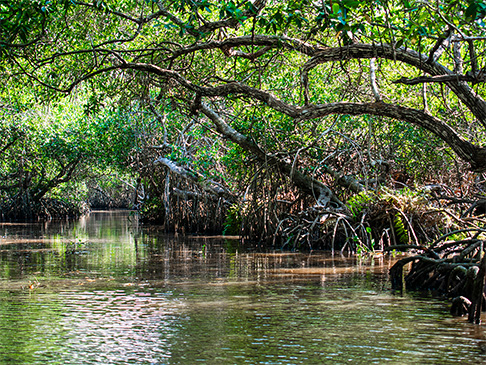MANGROVE DAMAGE AND EARLY STAGE CANOPY RECOVERY FOLLOWING HURRICANE ROSLYNE IN MARISMAS NACIONALES MEXICO
22/7/25

While mangroves are remarkably resilient and have developed various adaptations to withstand extreme weather conditions, hurricanes can still result in considerable mortality and fragmentation within these coastal forests. Photo credit: Diana Macias via Shutterstock
Hurricanes are powerful tropical storms that can severely damage mangrove forests through uprooting trees, sediment erosion, and saltwater intrusion, disrupting their critical role in coastal protection and biodiversity. After a hurricane, evaluating mangrove damage helps prioritize rehabilitation efforts, as these ecosystems play a key ecological role in coastal regions. Thus, we analyzed the defoliation of mangrove forest canopies and their early recovery, approximately 2.5 years after the landfall of Category 3 Hurricane Roslyn in October 2002 in Marismas Nacionales, Mexico. The following mangrove traits were analyzed: (1) the yearly time series of the Combined Mangrove Recognition Index (CMRI) standard deviation from 2020 to 2025, (2) the CMRI rate of change (slope) following the hurricane’s impact, and (3) the canopy height model (CHM) before and after the hurricane using satellite and UAV-LiDAR data. Hurricane Roslyn caused a substantial decrease in canopy cover, resulting in a loss of 47,202 ha, which represents 82.8% of the total area of 57,037 ha. The CMRI standard deviation indicated early signs of canopy recovery in one-third of the mangrove-damaged areas 2.5 years post-impact. The CMRI slope indicated that areas near the undammed rivers had a maximum recovery rate of 0.05 CMRI units per month, indicating a predicted canopy recovery of ~2.5 years. However, most mangrove areas exhibited CMRI rates between 0.01 and 0.03 CMRI units per month, anticipating a recovery time between 40 months (approximately 3.4 years) and 122 months (roughly 10 years). Unfortunately, most of the already degraded Laguncularia racemosa forests displayed a negative CMRI slope, suggesting a lack of canopy recovery so far. Additionally, the CHM showed a median significant difference of 3.3 m in the canopy height of fringe-type Rhizophora mangle and Laguncularia racemosa forests after the hurricane’s landfall.





Watch the video here:


